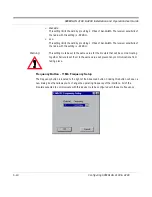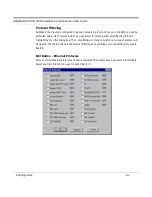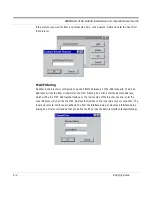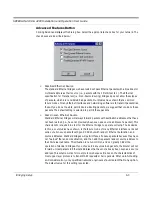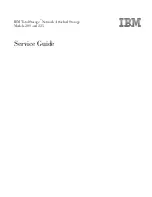
SPEEDLAN 4100 & 4200 Installation and Operation User Guide
7-2
Setting Up the IP Addresses (IP Host Setup)
If you do not understand the basics of IP addressing, DHCP, or NAT, please read the next section,
Part I - Quick Overview of IP Addressing below. Otherwise, skip to
Part II - Setting Up the IP Address,
Part I - Quick Overview of IP Addressing
IP Addressing is important because it tells the network how to locate the computers or network
equipment connected to it. IP addresses are given so each computer or equipment on the network
contains a unique address. In addition, network addresses and node addresses, depending on the
Class (A, B, C, etc.), contain their own unique address as well. IP addressing provides the following
information:
•
Provides communication between different platforms and diverse systems
•
Provides universal data transfer over large geographic distances
•
Has been "adopted" as a standard in the computer industry
What is an IP address?
An IP address contains 32 bits of information, which is divided into the following:
•
Two sections: the network address and the node address (also known as the host address)
•
To keep it simple, lets call it four bytes (octets)
Note:
Each octet contains 8 bits, which are equivalent to 1 byte. Each octet is separated by a
period (.).
The following examples show the conversion of the same IP address into several different formats:
•
Decimal (130.57.30.56)
•
Hexadecimal (82.39.1E.38)
•
Binary (10000010.00111001.00011110.00111000).
Summary of Contents for SPEEDLAN 4100
Page 7: ...Chapter 1 Introduction...
Page 11: ...Chapter 2 Quick Start...
Page 21: ...Chapter 3 Hardware...
Page 25: ...Chapter 4 Overview of Configurator...
Page 31: ...Chapter 5 Configuring SPEEDLAN 4100 4200...
Page 43: ...Chapter 6 Bridging Setup...
Page 53: ...Chapter 7 Setting Up the IP Addresses IP Host Setup...
Page 67: ...Chapter 8 IP Router Setup...
Page 73: ...Chapter 9 SNMP Setup...
Page 77: ...Chapter 10 System Access Setup...
Page 79: ...Chapter 11 SNMP Monitoring...
Page 105: ...Chapter 12 Tables...
Page 115: ...Chapter 13 Analyzing Wireless Equipment...
Page 123: ...Glossary for Standard Data Communications...

